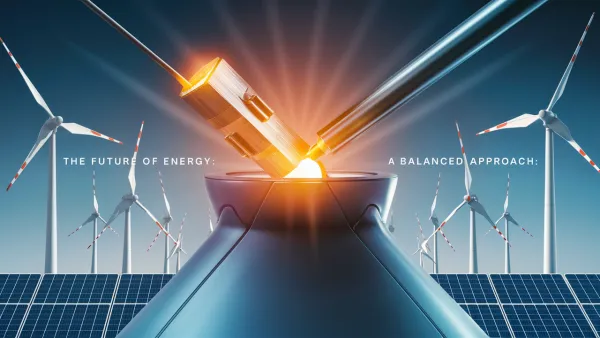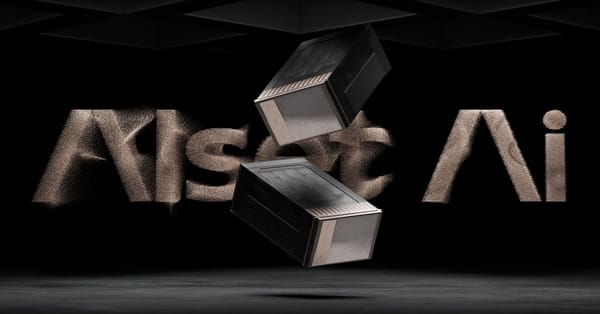Alaska Energy Metals Intersects Nickel Sulfide Mineralization Over Significant Widths, Nikolai Nickel Project, Alaska
Alaska Energy Metals reported successful drilling outcomes at its Nikolai Nickel Project in Alaska, revealing significant nickel sulfide mineralization. Assay results from two holes show promising nickel, copper, and cobalt concentrations, confirming historical drilling results.

Highlights:
- Drilling of eight diamond drill holes totaling 4,138 meters was completed during the 2023 campaign, and assay results from drill holes EZ-23-001 & EZ-23-002 have been received. Six holes remain pending.
- Drill hole EZ-23-001 returned 341.6 meters(m) @ 0.23% Ni, 0.08% Cu, 0.02% Co, 0.107 g/t Pd, 0.051 g/t Pt and 0.011 g/t Au (0.34% Nickel Equivalent (“NiEq”). EZ-23-001 was collared approximately 100m southwest of historical drill hole PNI-10-036 and confirmed the previously reported historical drilling results in that hole.
- Drill hole EZ-23-002 returned 296.6m @ 0.23% Ni, 0.09% Cu, 0.02% Co, 0.115 g/t Pd, 0.052 g/t Pt and 0.013 g/t Au (0.35% NiEq). EZ-23-003 was collared approximately 300m northwest of EZ-23-001.
- Drilling results demonstrate consistent mineralization and the potential to accelerate publication of a maiden bulk tonnage resource early in 2024.
- Additionally, 27-line kilometers of CSAMT geophysical surveys and 16-line kilometers of EM surveys were completed, primarily on the Canwell claim block, to analyze future high-priority drill targets.
Alaska Energy Metals President & CEO Gregory Beischer commented: “We intersected exactly what we expected with these initial holes. The main Eureka Zone appears to be remarkably persistent and homogeneous in metal concentration and the width of the mineralized zone is quite significant. With a 100-meter step-out, assay results from EZ-23-001 confirmed the grade historically encountered in drillhole PNI-10-036. Two additional, parallel zones of mineralization may have been revealed within the current and historical drilling datasets. With all the historical drill hole logs and assays now in hand, we see potential to accelerate the publication of a maiden resource at what we view as an emerging base metal district.”
VANCOUVER, BRITISH COLUMBIA, October 16, 2023 – Alaska Energy Metals Corporation (TSX-V: AEMC, OTCQB: AKEMF) (“AEMC” or the “Company”) is pleased to announce the completion of its 2023 exploration program at the 100% owned Nikolai Nickel Project in central Alaska (Figure 1).
2023 Exploration Update
- Eight diamond drill holes, totaling 4,138 meters (m), were drilled over a 1.2-kilometer (km) strike length of the Eureka Zone. Results for the first two drill holes EZ-23-001 & EZ-23-002 have been received, with assay results for the remaining six holes pending.
- In addition to the drill program, the Company carried out 27-line km of ground-based Controlled-source Audio-frequency Magnetotellurics (CSAMT) surveys on the Eureka and Canwell claim blocks, as well as 16-line km of ground-based Electromagnetic (EM) surveys on the Canwell claim Block. The surveys, in conjunction with the recently purchased historical data set, will be used to analyze and prioritize drill targets for the 2024 exploration campaign.
- The 2023 exploration drill program was completed using one surface diamond drill rig (Figure 2). The program consisted of eight holes drilled into the main Eureka Zone mineralization (Table 1). EZ-23-001 was drilled ~100m southwest of historical drillhole PNI-10-036 to validate geology and historical assay results. The additional seven holes were drilled at approximately 250m to 300m offsets to test grade and thickness of a 1.2-km strike length of the Eureka Zone (Figure 3).
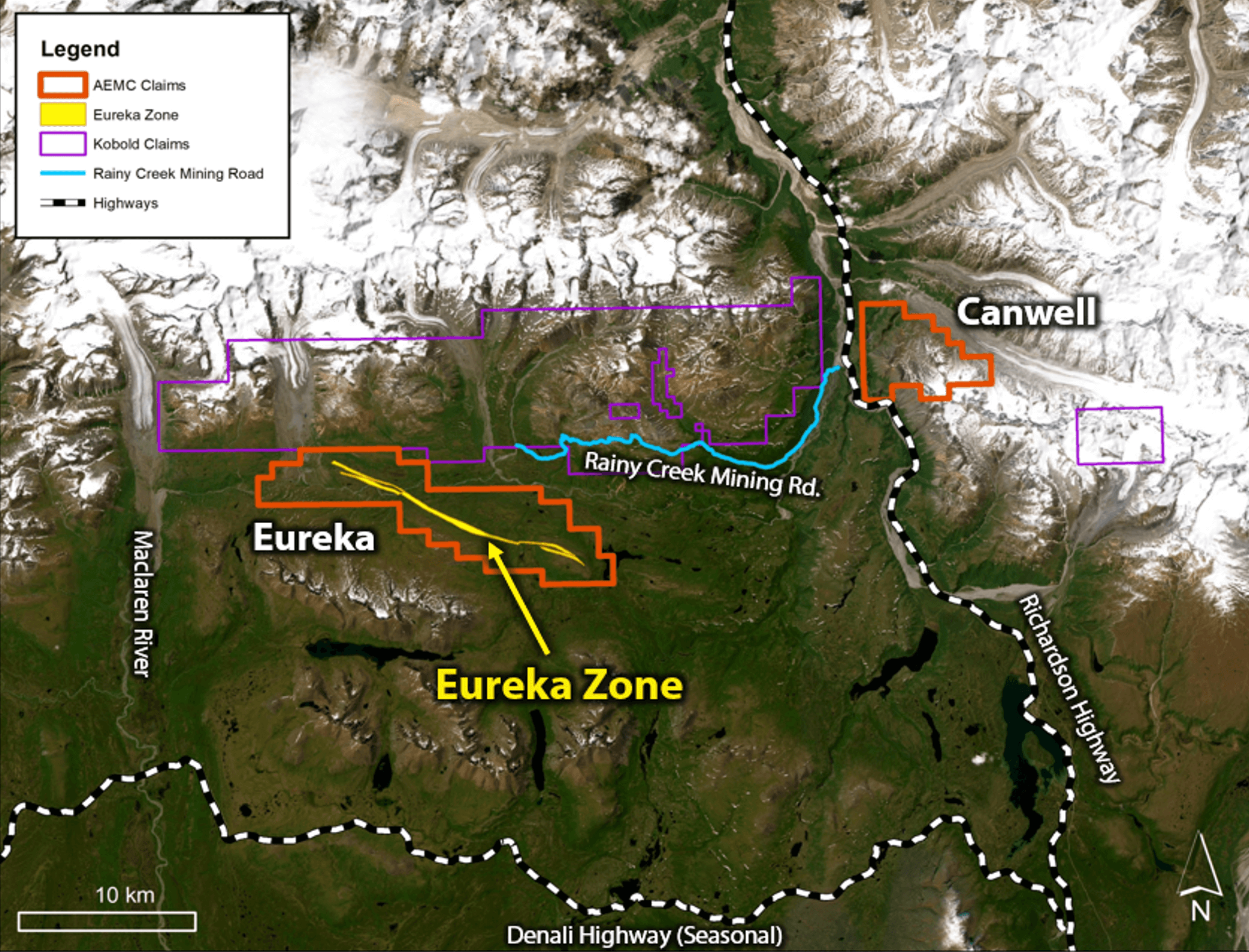
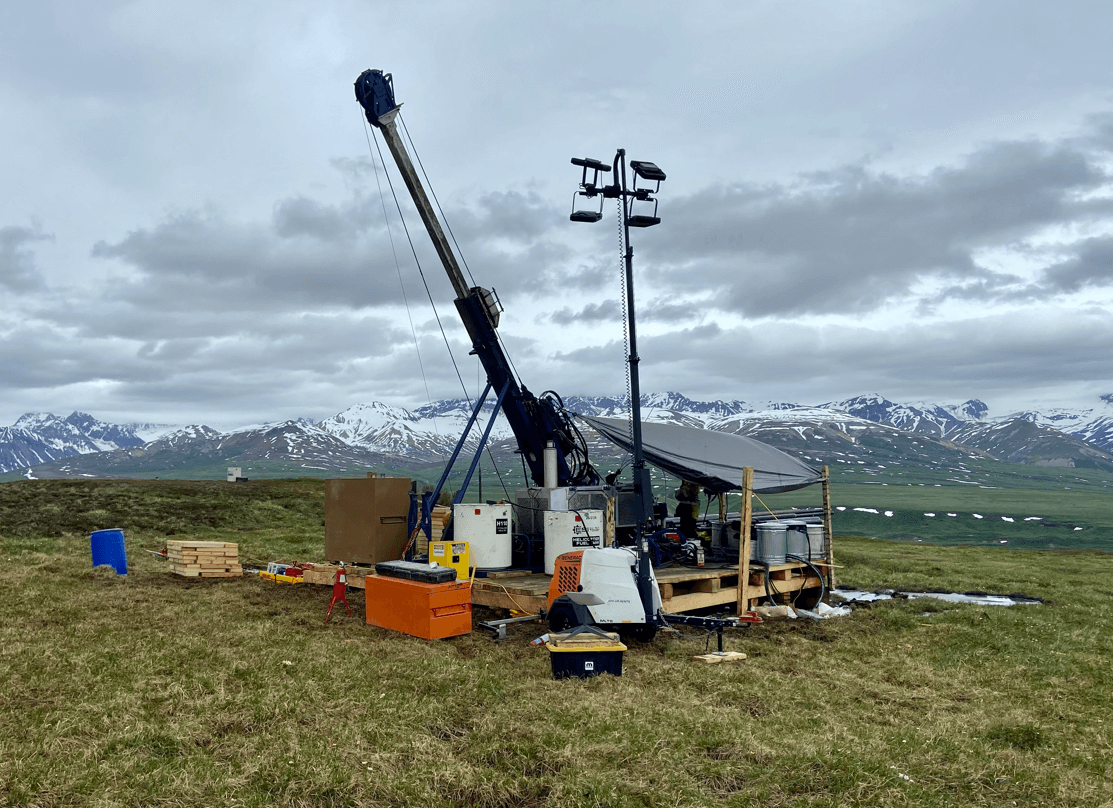
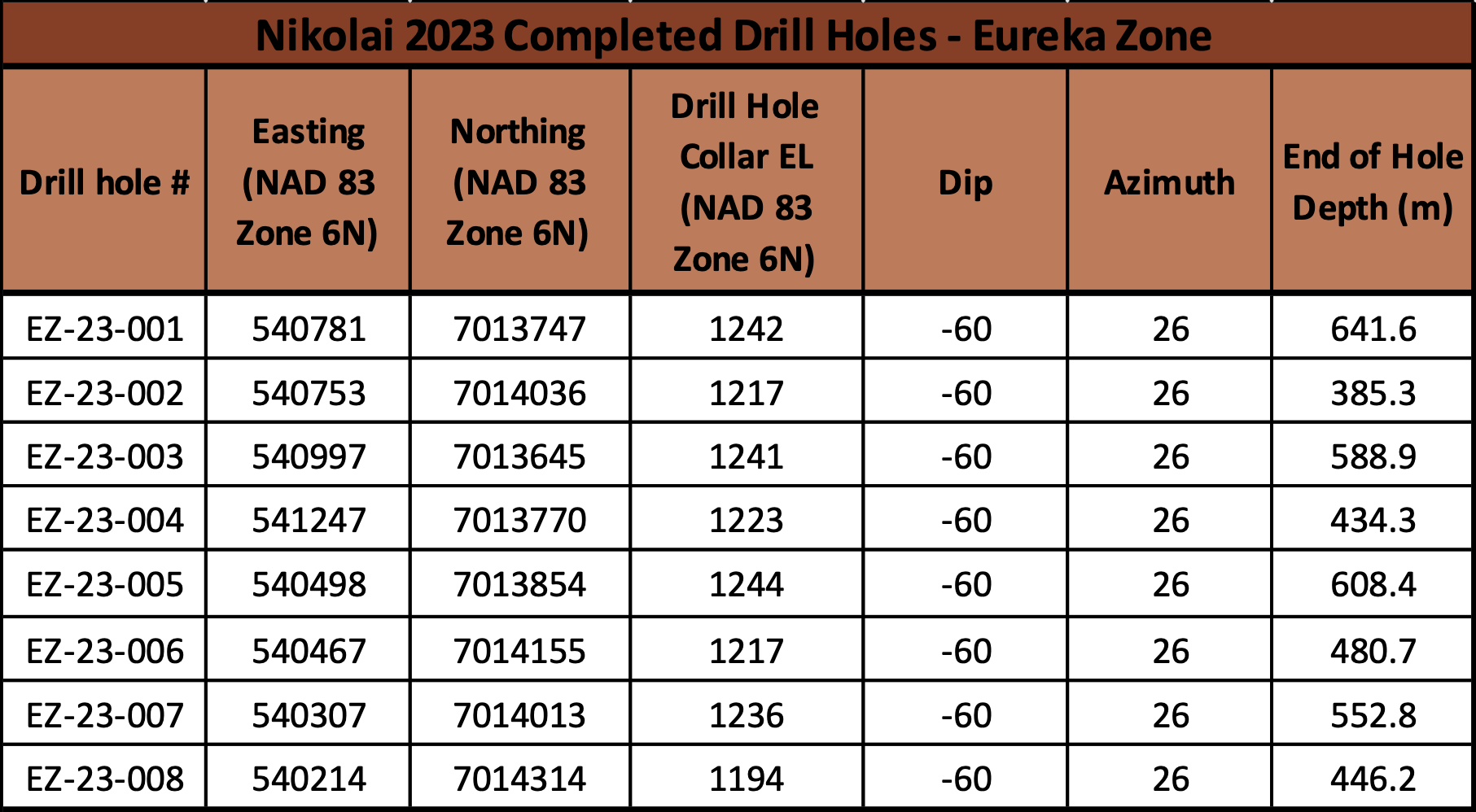
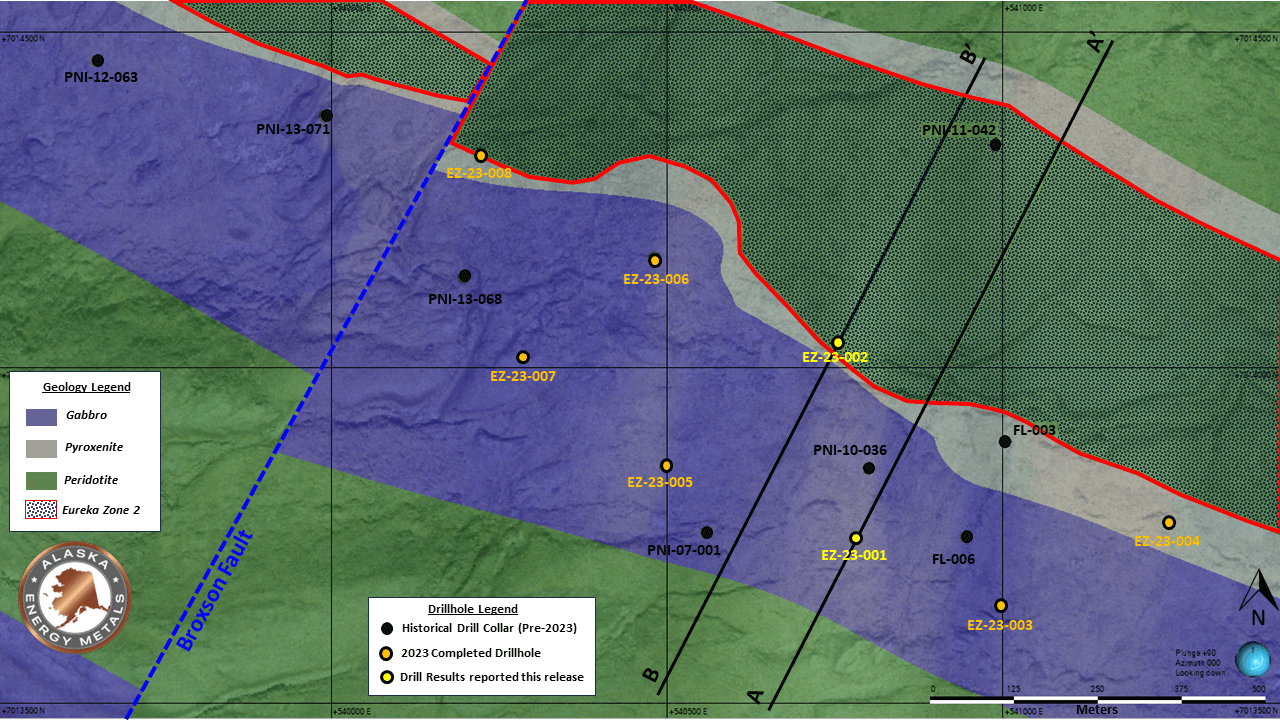
Hole EZ-23-001 Summary
- The hole pierced 16.2m of overburden and then drilled into a poorly mineralized gabbro from 16.2m to 148.0m. The gabbroic unit transitioned into a weakly mineralized pyroxenite-rich unit from 148.0m to 220.1m.
- The main mineralized Eureka zone was intersected at target depth from 220.1 to 561.7m downhole, with assays grading 341.6m @ 0.23% Ni, 0.08% Cu, 0.02% Co, 0.32% Cr, 9.94% Fe, 0.107 g/t Pd, 0.051 g/t Pt and 0.011 g/t Au (0.34% NiEq) (Table 2 and Figure 4).
- The main mineralized zone was hosted within a pervasively serpentinized peridotite, with varying amounts of disseminated sulfides, with up to 10% disseminated sulfides within the Core Eureka Zone 2 (Figure 5).
- Grades and sulfide abundance within the main mineralized zone decrease near the contact with a pyroxenite intrusive rock phase from 593.6m to 608.7m.
- Another pervasively serpentinized peridotite, with an increase in disseminated sulfides, was intersected from 608.7m to 614.6m (EOH). This lower peridotite unit assayed 49.4m @ 0.15 Ni%, 0.02 Cu%, 0.02% Co, 0.44 Cr%, 10.25% Fe, 0.017 g/t Pd, 0.031 g/t Pt and 0.008 g/t Au (0.21% NiEq) and remains open at depth.
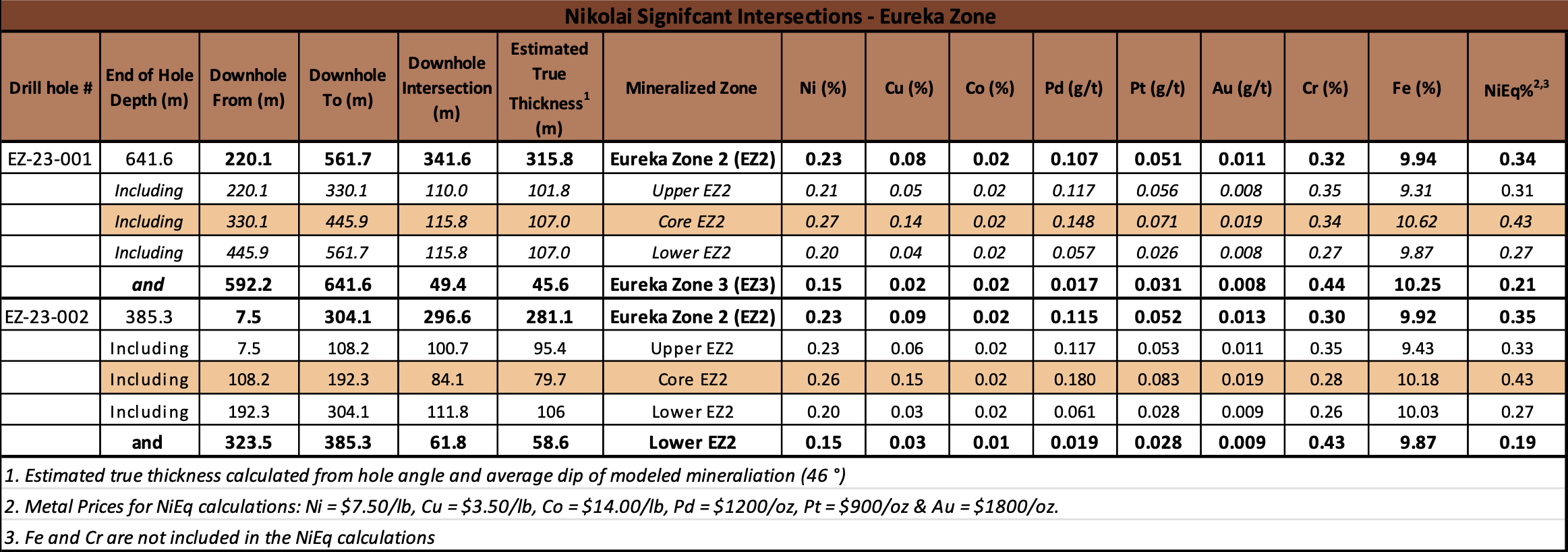
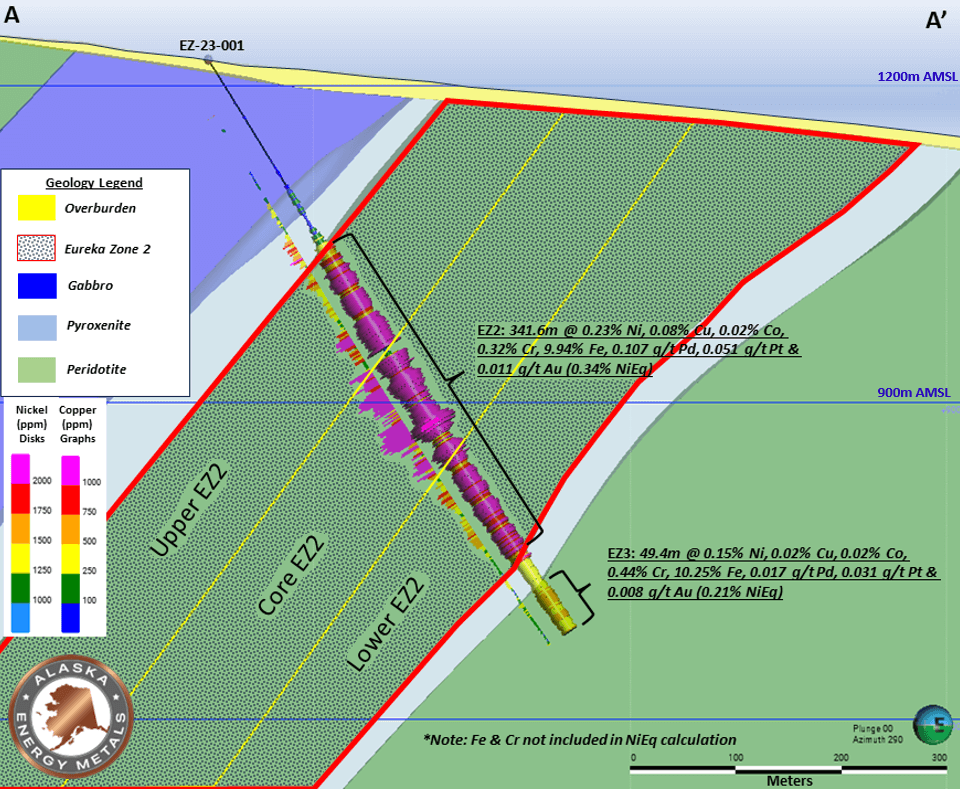
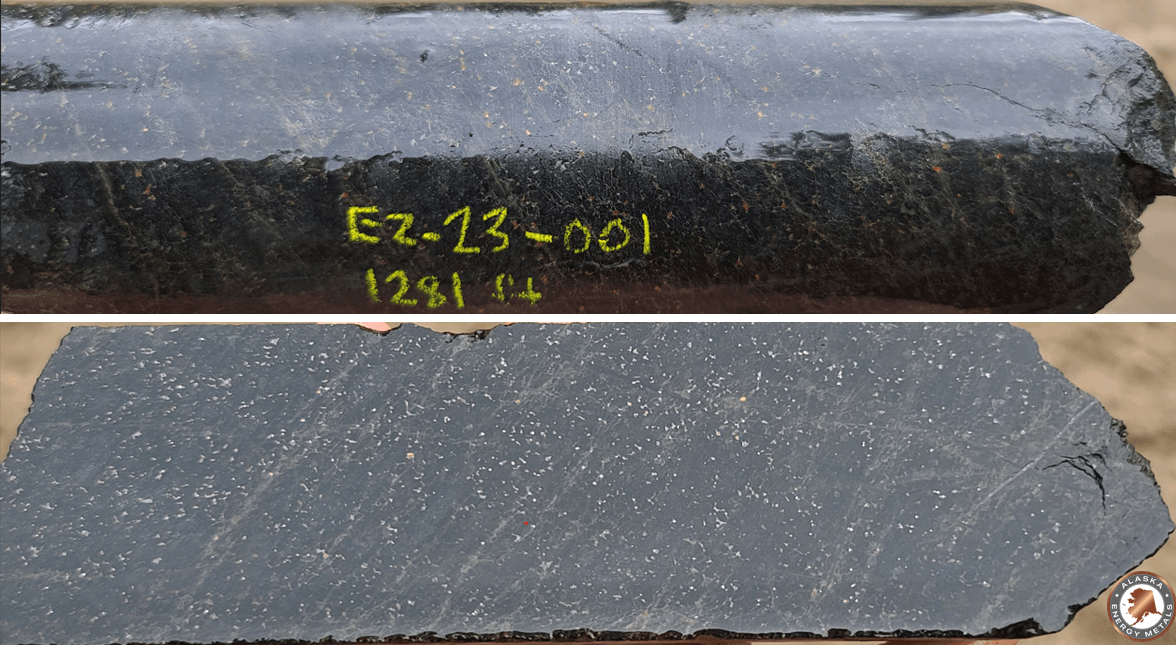
EZ-23-002 Summary
- This hole drilled into 7.5m of overburden and then into the main mineralized Eureka Zone.
- The Eureka zone was intersected from 7.5m to 304.1m downhole, with assays grading 296.6m @ 0.23% Ni, 0.09% Cu, 0.02% Co, 0.30% Cr, 9.92% Fe, 0.115 g/t Pd, 0.052 g/t Pt and 0.013 g/t Au (0.35% NiEq) (Table 2 and Figure 6).
- The main mineralized zone was hosted within a pervasively serpentinized peridotite, with varying amounts of disseminated sulfides and up to 10% disseminated sulfides within the Core Eureka Zone 2.
- Grades and sulfide abundance within the main mineralized zone decrease near the contact with a pyroxenite intrusive phase from 304.1m to 323.5m.
- Another pervasively serpentinized peridotite, with an increase in disseminated sulfides, was intersected from 323.5m to 385.3m (EOH). This lower peridotite unit assayed 61.8m @ 0.15 Ni%, 0.03 Cu%, 0.01% Co, 0.43 Cr%, 9.87% Fe, 0.019 g/t Pd, 0.028 g/t Pt and 0.009 g/t Au (0.19% NiEq) and is still open at depth.
- The company is currently evaluating the recently purchased historical drill hole dataset for indications of whether this lower serpentinized dunite intersected in EZ-23-001 and EZ-23-002 could be a separate mineralized intrusion along the entire strike length of the Eureka Zone.
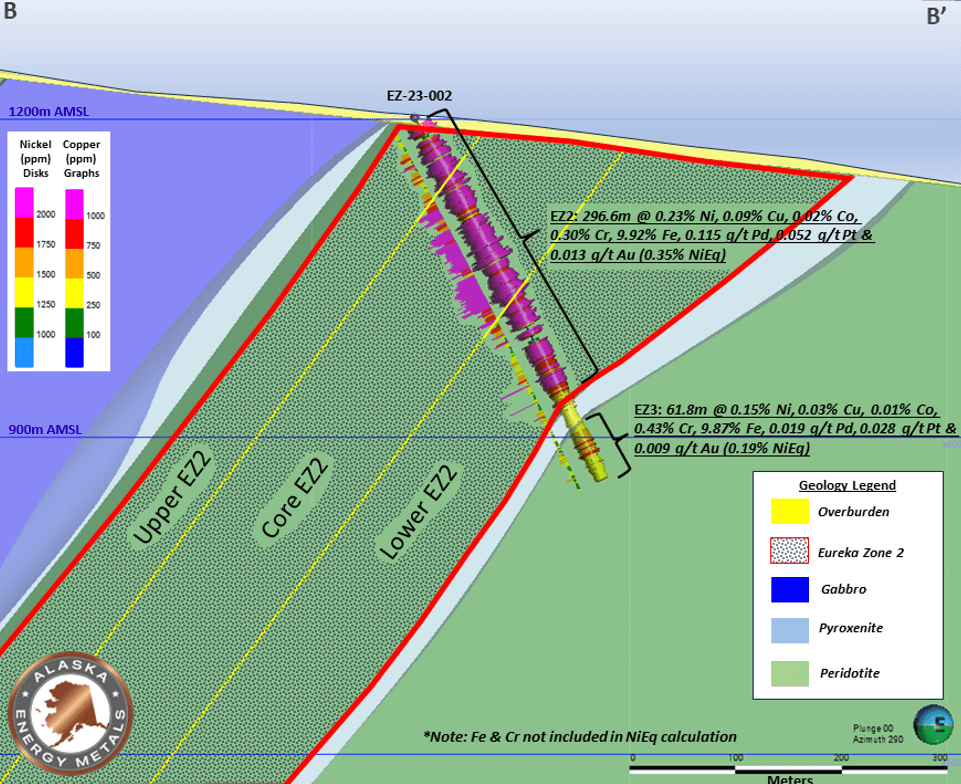
CSAMT/Geophysical Surveys
- A total of 20km was completed over the Canwell claim block, with an additional 7 line-km completed over the Eureka Zone.
- The purpose of the CSAMT surveys was to map subsurface geology and to analyze whether known mineralization could be detected within the Eureka Zone using this survey method.
- An additional 16 line-km of EM surveys were completed over the Canwell claim block where CSAMT surveys had detected ultramafic rocks in the subsurface. The Company is awaiting the results of the EM surveys.
Core Processing & Quality Assurance/Quality Control (QA/QC)
Alaska Energy Metals adheres to stringent Quality Assurance – Quality Control (“QA/QC”) standards for its Nikolai Nickel Project to ensure the best practices for logging, sampling, and analysis of samples. For every 10 core samples, one geochemical blank, one coarse reject, one pulp duplicate, or one nickel – copper – platinum group element - gold certified reference material standards (CRMs) are inserted into the sample stream.
Drill core was flown by helicopter daily from drill sites and transported in secured wooden core boxes to the core logging facilities in Delta Junction, Alaska. Detailed logging and sampling data was captured on tablets using MX Deposit software. Samples were labeled by geologists and sawn in half with a diamond blade, with half being inserted into a labeled, bar coded, sample bag. The other half of the core was returned to the wooden boxes for archive at a secure location. Samples are transported in sealed bags to SGS Laboratories in Burnaby, B.C. utilizing a contracted transportation carrier.
Once samples are received at the laboratory, they are weighed, dried, and crushed to 75% passing 2mm. The samples are then riffle split and pulverized to 85% passing 75 microns. The samples are pulverized in a zirconia bowl, to prevent the contamination of Fe and Cr. Au, Pt, & Pd are analyzed by fire assay with ICP-AES finish (GE_FAI30V5). Ag is analyzed using a 4-acid digest with AAS finish (GE_AAS42E50). The remaining 30 elements are analyzed using sodium peroxide fusion with ICP-AES finish (GE_ICP90A50).
Qualified Person
Gabriel Graf, the Company’s Chief Geoscientist, is the qualified person, as defined under National Instrument 43-101 Standards of Disclosure for Mineral Projects, responsible for, and having reviewed and approved, the technical information contained in this news release.
For additional information, visit: https://alaskaenergymetals.com/
About Alaska Energy Metals
Alaska Energy Metals Corporation is focused on delineating and developing a large polymetallic exploration target containing nickel, copper, cobalt, chrome, iron, platinum, palladium, and gold. Located in central Alaska near existing transportation and power infrastructure, the project is well-situated to become a significant, domestic source of critical and strategic energy-related metals for the American market.

